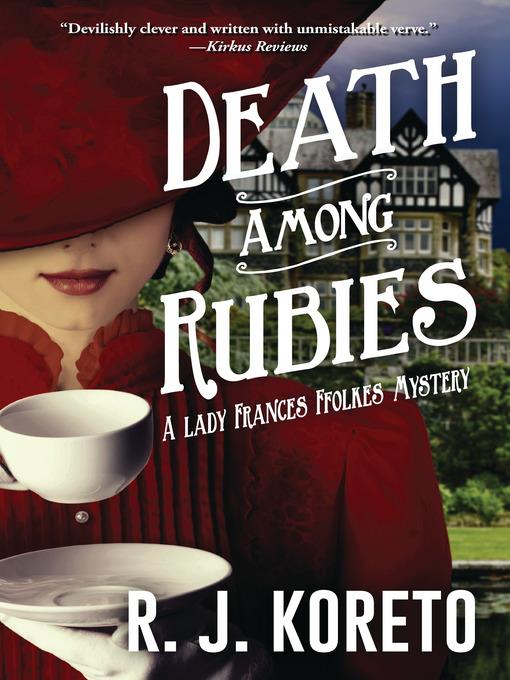
Death Among Rubies
Lady Frances Ffolkes Mystery
کتاب های مرتبط
- اطلاعات
- نقد و بررسی
- دیدگاه کاربران
نقد و بررسی

August 15, 2016
Koreto’s appealing sequel to Death on the Sapphire takes Edwardian suffragette Lady Frances Ffolkes and her maid, June Mallow, to Kestrel’s Eyrie outside Morchester, England. Gwendolyn Kestrel has invited her extremely close friend, Thomasina Calvin, and Franny to visit the country manor while her father is hosting several diplomatic guests. Soon after the ladies arrive, Mallow finds Gwen’s father, Sir Calleford, stabbed to death with a ruby-inlaid Turkish dagger. Franny sets out to get to the bottom of things with Mallow’s help, but the local police aren’t interested in their assistance. When Inspector Eastley arrives from Scotland Yard, he reluctantly accepts Franny as a translator for the French guests, having learned from a previous case that Lady Frances is not to be denied. The delightful Franny and Mallow soon discover familial as well as political motives behind the crime. Koreto nicely blends international intrigue and affairs of the heart. Agent: Cynthia Zigmund, Second City Publishing Services.

A suffragette sleuth solves a baffling murder, to the chagrin of Scotland Yard.While Lady Frances Ffolkes' avid suitor, Henry Wheaton, the esteemed barrister and amateur portraitist, paints her portrait, British diplomat Sir Calleford Kestrel entertains a diverse assembly of guests at his estate, Kestrel's Eyrie. Frances and her equally brusque maid, Mallow, will soon join the assembly as guests of Sir Calleford's daughter, Gwen, and her "great friend" Thomasina. At the end of Sir Calleford's first appearance, Koreto announces portentously that "no one would ever see Sir Calleford alive again." Mallow discovers Sir Calleford, slumped in his chair in the study, with an elegant curved dagger in his back. Because of Sir Calleford's status, Scotland Yard sends two members of the Special Branch. Inspector Eastley is surprised and chagrined to find Frances among the company, but she's nonplussed at meeting him again. Adding insult to injury, Eastley is forced to use Frances as an interpreter for his interrogation of a suspicious guest, Mme. Aubert. Despite Eastley's disapproval, Frances continues to probe on her own. An anonymous letter to Thomasina, maligning her relationship with Gwen, accusing her of murder and threatening her, helps provide a focus for Frances. Mallow, meanwhile, advised to keep an ear out for gossip, takes the advice above and beyond, cozying up to friendly Constable Dill.Though its stereotypes and set pieces are sometimes presented with a heavy hand, Koreto's second case for his titled heroine (Death on the Sapphire, 2016) is devilishly clever and written with unmistakable verve. COPYRIGHT(1) Kirkus Reviews, ALL RIGHTS RESERVED.

August 1, 2016
A suffragette sleuth solves a baffling murder, to the chagrin of Scotland Yard.While Lady Frances Ffolkes avid suitor, Henry Wheaton, the esteemed barrister and amateur portraitist, paints her portrait, British diplomat Sir Calleford Kestrel entertains a diverse assembly of guests at his estate, Kestrels Eyrie. Frances and her equally brusque maid, Mallow, will soon join the assembly as guests of Sir Callefords daughter, Gwen, and her great friend Thomasina. At the end of Sir Callefords first appearance, Koreto announces portentously that no one would ever see Sir Calleford alive again. Mallow discovers Sir Calleford, slumped in his chair in the study, with an elegant curved dagger in his back. Because of Sir Callefords status, Scotland Yard sends two members of the Special Branch. Inspector Eastley is surprised and chagrined to find Frances among the company, but shes nonplussed at meeting him again. Adding insult to injury, Eastley is forced to use Frances as an interpreter for his interrogation of a suspicious guest, Mme. Aubert. Despite Eastleys disapproval, Frances continues to probe on her own. An anonymous letter to Thomasina, maligning her relationship with Gwen, accusing her of murder and threatening her, helps provide a focus for Frances. Mallow, meanwhile, advised to keep an ear out for gossip, takes the advice above and beyond, cozying up to friendly Constable Dill.Though its stereotypes and set pieces are sometimes presented with a heavy hand, Koretos second case for his titled heroine (Death on the Sapphire, 2016) is devilishly clever and written with unmistakable verve.
COPYRIGHT(2016) Kirkus Reviews, ALL RIGHTS RESERVED.

September 1, 2016
As she leaves evensong at St. Paul's Cathedral, Thomasina Tommie Calvin is accosted and a threat hissed: don't go to Kestrel's Eyrie. Shaken, Tommie and her friend Gwendolyn, whose father owns the estate, travel there anyway, along with fellow suffragette, Lady Frances Ffolkes. They are joining a house party hosted by Sir Calleford; the other guests, by contrast, are foreign dignitaries from Turkey and France, and a brash American heiress and her parents. Just as the three women arrive, Sir Calleford is found in his library, stabbed with a ruby-encrusted Turkish dagger from his collection. Everyone is now a suspect in this closed-house mystery. June Mallow, Frances' stalwart maid, works the downstairs while her mistress gathers clues, confronting obstacles put up by the local constabulary, as Frances' linguistic skills are put to use for interrogation. Koreto skillfully contrasts the feminist milieu of 1907 England with the establishment class structure. Lady Frances and Mallow are an effective pairing, and the romantic relationship between Frances and the family solicitor, Henry Wheaton, continues to grow in this second in the series.(Reprinted with permission of Booklist, copyright 2016, American Library Association.)

























دیدگاه کاربران